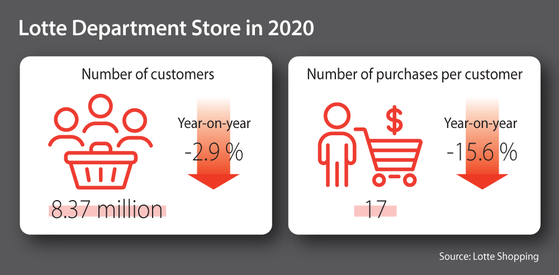Shopping patterns evolve as the pandemic drags on
![Customers enter Lotte Department Store's main branch in Jung District, central Seoul, on Nov. 13, 2020. [NEWS1]](https://koreajoongangdaily.joins.com/data/photo/2021/01/20/87f6e309-e621-4eb4-a57d-6c15daa2bdb4.jpg)
Customers enter Lotte Department Store's main branch in Jung District, central Seoul, on Nov. 13, 2020. [NEWS1]
“I used to go department stores about two to three times a month to buy some necessities and purchase clothes for my children,” Kim said. “But after the pandemic, I barely go shopping.”
The pandemic has changed Korean shopping patterns. Fewer trips are made to the stores though more is spent per trip.
These are some of the findings detailed in an analysis published by JoongAng Ilbo using data on 320 million products purchased by customers at Lotte Department Store in 2019 and 2020. The analysis includes the changed shopping patterns of 8.37 million customers of Lotte Department Stores after the coronavirus outbreak.

Customers on average went shopping at Lotte Department Store about 6.1 times last year. In 2019, the number was 7.5. They purchased products about 144.2 million times last year, down 18 percent compared to a year earlier.
But customers spent more each visit. In 2019, a customer on average spent 170,000 won ($155) every time they visited Lotte Department Store. But that increased to 200,000 won last year, up 17 percent year-on-year.
Customers in the top quintile in terms of purchasing power spent 300,000 won per visit. It was 240,000 won in 2019.
“Although people visited department stores fewer times last year compared to previous years, [the data show that] they visited with more clear purchasing purposes,” said Kim Cheol-kwan, head of the data intelligence team at Lotte Department Store.
Customers stayed a shorter period of time at department stores.
Customers at Lotte Department Store on average stayed about five hours every time they visited in 2019, but this declined to four hours last year. Lotte Department Store said people became more reluctant to stay longer at department stores where many individuals gathered together.
The peak times for Lotte Department Store is normally 7 p.m., as many people go shopping after work. But the number of visitors to the department stores after 7 p.m. decreased by more than 5 percent last year compared to a year earlier.
“These days, I go shopping at around 3 p.m. to 4 p.m.,” said Na Hyun-ah, a 33-year-old woman who used to enjoy shopping after 7 p.m. “Now I'm afraid to go shopping after 7 p.m. because department stores are always crowded during that time as more people visit after work.”
Koreans now tend to use their own vehicles — instead of using public transportation — when they go shopping.
According to the data, the number of customers who went shopping with their own vehicles jumped by 138 percent last year compared to a year earlier.
They were also very cautious about various services offered by department stores.
The number of customers who used the baby stroller-sharing service in department stores decreased by 78 percent on year.
The number of stores they visited decreased to 1.5 last year compared to 2019’s 2.2.
Spending by those born in the early 1980s to early 2000s increased by 1 percent last year compared to the previous year. Lotte Department Store says that growing spending by people in this age group despite the coronavirus outbreak is closely related to the increasing number of single-person households.
The spending by single-person households who are university students and office workers rose by some 24 percent to 32 percent on year, according to Lotte Department Store.
“After the coronavirus pandemic started, customers visited department stores fewer times but with more clear spending purposes,” said Hyun Jong-hyuk, head of the customer experience team at Lotte Department Store. “Analyzing customer shopping patterns and offering them a suitable shopping experience instead of displaying everything at a time are essential for retailers to survive.”
BY LEE SOO-KI [chea.sarah@joongang.co.kr]










with the Korea JoongAng Daily
To write comments, please log in to one of the accounts.
Standards Board Policy (0/250자)